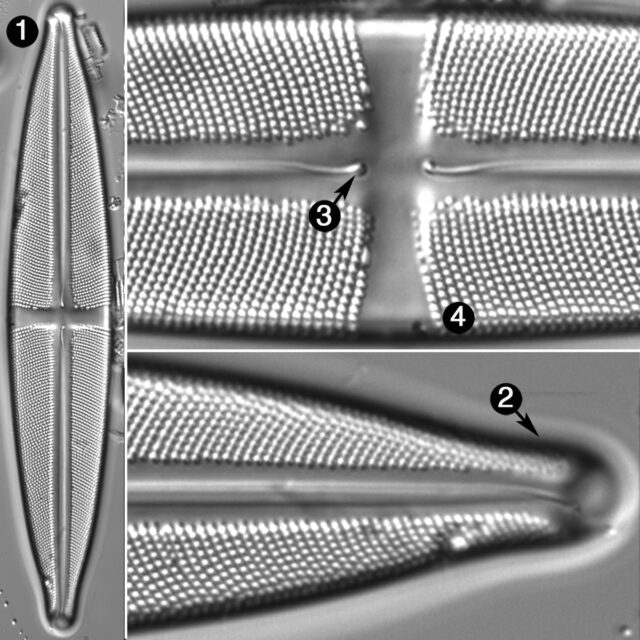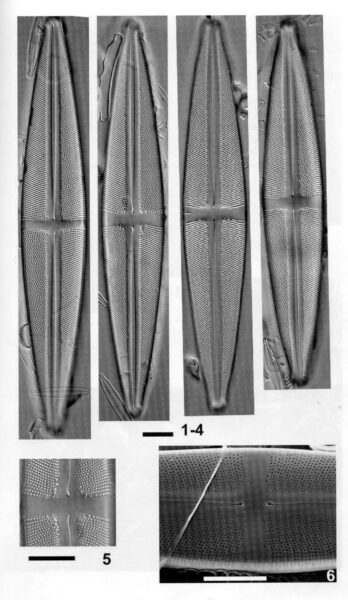Stauroneis supergracilis
-
Category
-
Length Range124-213 µm
-
Width Range21-33 µm
-
Striae in 10 µm15-16
-
Reported AsStauroneis phoenicenteron f. gracilis (Patrick and Reimer 1966)
Stauroneis phoenicenteron f. gracilis (Camburn and Charles 2000)
Stauroneis regina (Bahls 2010)
-
ContributorLoren Bahls - May 2012
-
ReviewerMark Edlund - Jun 2012
Identification
Description
Valves are narrowly lanceolate with subtly protracted apices. The axial area is linear and two to three times wider than the raphe. The stauros is rectangular, often widening slightly near the valve margins. Short striae are absent from the stauros. The raphe is lateral with curved and inflated proximal ends. Terminal raphe fissures are hooked toward the secondary side. Striae are radiate throughout. Areolae are relatively coarse and number 14-18 in 10 µm.
Autecology
Stauroneis supergracilis is widely distributed in lakes, ponds, and wetlands in the Northern Rockies. The pH of these waters ranges from 5.5 to 8.6 (mean pH = 6.7) and specific conductance ranges from 7 to 168 µS/cm (mean SC = 63 µS/cm). Van de Vijver et al. (2004) report this species from the sub-Antarctic, where it was found in a large shallow pool with slightly acid pH (6.6) and low specific conductance (<100 µS/cm).
-
Size Range, µm3
-
Motility
-
Attachment
-
Habitat
-
Colony
-
Waterbody
-
Distribution
- Learn more about this
Original Description
Differential diagnosis compared to Stauroneis gracilis Ehrenberg: Valves relatively narrow-lanceolate with hardly protracted, simply bluntly rounded ends, valves gradually attenuating towards the ends (and not linear- or elliptic-lanceolate with protracted, subrostrate ends). Length 120-140 µm, breadth 20-22 µm (and not 75-120 µm and 15-20 µm). Raphe distinctly lateral with central external endings significantly curved with moderately deflected pores towards the secondary side of the valve (as in St. gracilis). Axial area almost linear and moderately broad, hardly widened near the central area. Central area forming a somewhat irregular fascia as to breadth, moderately widened towards the margins. Striae strongly radiate throughout, 16-17 in 10 µm. Puncta in the striae not very densely spaced, 17-18 (and not 18-21) in 10 µm. In the central area, sometimes (a few) irregularly shortened striae are present.
-
AuthorVan de Vijver and Lange-Bert. 2004
-
Length Range120-140 µm
-
Width20-22 µm
-
Striae in 10µm16-17
Citations & Links
Citations
Links
Cite This Page
Bahls, L. (2012). Stauroneis supergracilis. In Diatoms of North America. Retrieved April 20, 2024, from https://diatoms.org/species/stauroneis_supergracilis
Responses
The 15 response plots show an environmental variable (x axis) against the relative abundance (y axis) of Stauroneis supergracilis from all the stream reaches where it was present. Note that the relative abundance scale is the same on each plot. Explanation of each environmental variable and units are as follows:
ELEVATION = stream reach elevation (meters)
STRAHLER = distribution plot of the Strahler Stream Order
SLOPE = stream reach gradient (degrees)
W1_HALL = an index that is a measure of streamside (riparian) human activity that ranges from 0 - 10, with a value of 0 indicating of minimal disturbance to a value of 10 indicating severe disturbance.
PHSTVL = pH measured in a sealed syringe sample (pH units)
log_COND = log concentration of specific conductivity (µS/cm)
log_PTL = log concentration of total phosphorus (µg/L)
log_NO3 = log concentration of nitrate (µeq/L)
log_DOC = log concentration of dissolved organic carbon (mg/L)
log_SIO2 = log concentration of silicon (mg/L)
log_NA = log concentration of sodium (µeq/L)
log_HCO3 = log concentration of the bicarbonate ion (µeq/L)
EMBED = percent of the stream substrate that is embedded by sand and fine sediment
log_TURBIDITY = log of turbidity, a measure of cloudiness of water, in nephelometric turbidity units (NTU).
DISTOT = an index of total human disturbance in the watershed that ranges from 1 - 100, with a value of 0 indicating of minimal disturbance to a value of 100 indicating severe disturbance.

Stauroneis supergracilis
- Valves narrowly lanceolate
- Apices subtly protracted
- Proximal raphe ends curved and inflated
- Areolae 14-18 in 10 µm
Stauroneis supergracilis has large, narrowly lanceolate valves, 124-213 µm long, with subtly protracted apices. Proximal raphe ends are curved and inflated. Areolae are relatively coarse and number 14-18 in 10 µm.
 Diatoms of North America
Diatoms of North America








